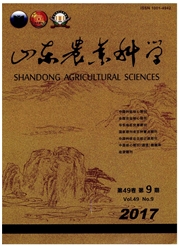

 中文摘要:
中文摘要:
小麦基部节间长度和茎秆直径是鉴评小麦抗倒伏性的重要指标。以两个主栽小麦品种花培3号和豫麦57为亲本获得的含有168个株系的DH(双单倍体)群体为材料,于3个不同的环境下种植,对小麦基部第一节间长度(L1)、基部第二节间长度(12)、基部第二节问直径(Dia)进行相关性分析。结果表明:DH群体的上述3个性状均表现出双向超亲分离现象,并接近于正态分布。基部第一、二节间长度呈极显著正相关,第二节间直径与一、二节间长度呈极显著正相关,三者关系极为密切。3个环境中,基部第一、二节问长度间的相关性都是最高的,相关系数达0.833^**。与正常播种相比,晚播条件下,基部第二节间长度与基部第一节间长度、基部第二节间直径间的相关系数明显变小(0.583^**〈0.650^**,0.263^**〈0.408^**),而基部第一节间长度与基部第二节间直径间的相关性没有明显变化(0.304^**≈0.309^**)。
 英文摘要:
英文摘要:
The basal elongated internode length and stalk diameter are important parameters for evaluating lodging resistance of wheat. In this paper, a doubled haploid (DH) population comprising 168 progeny lines, which were derived from a cross between two elite Chinese wheat cuhivars Huapei 3 and Yumai 57, was cultivated under three conditions. The correlation analysis was done on the relationships among the length of the first and second basal elongated internodes and stalk diameter. The results indicated that the three characteristics of the DH population displayed transgressive segregation in two directions and the segregation patterns largely conformed to normal distribution. The correlation between the length of the first and second basal elongated internodes was very significant, and also between the diameter of second internode and the length of the first and second basal elongated internodes. The correlation coefficient between the length of the first and second basal elongated internodes was the largest under all three conditions, with the value as 0. 833^ * *. The coefficients of correlation between the length of the first and second basal elongated internodes and between the length of second basal elongated internode and the second internode diameter under late
 同期刊论文项目
同期刊论文项目
 同项目期刊论文
同项目期刊论文
 Mapping of QTL for tiller number at different stages of growth in wheat using double haploid and imm
Mapping of QTL for tiller number at different stages of growth in wheat using double haploid and imm 期刊信息
期刊信息
